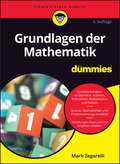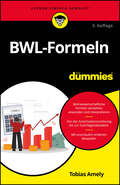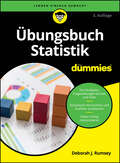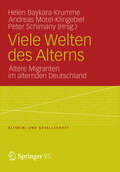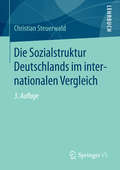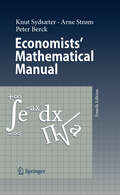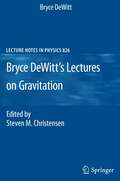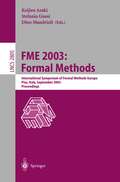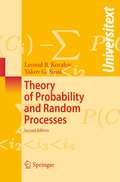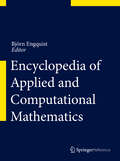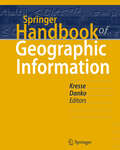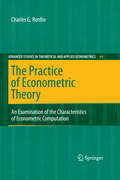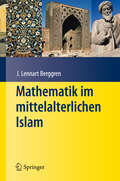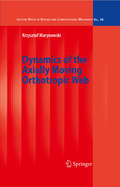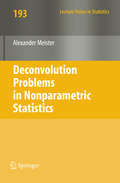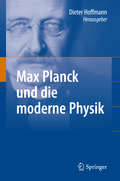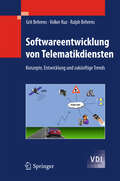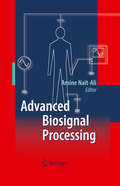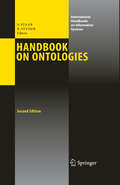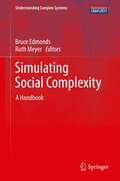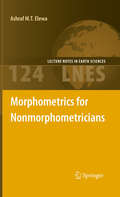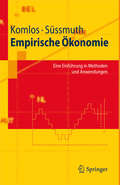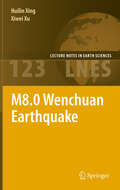- Table View
- List View
Grundlagen der Mathematik für Dummies (Für Dummies)
by Mark ZegarelliRuckzuck Mathematik verstehen Mathematik liegt nicht allen und oft sind es gerade die Grundlagen, die fehlen: Wie berechnet man nochmal den Umfang eines Kreises? Wieviel Geld spare ich bei 30 Prozent Rabatt? Und was war doch gleich ein unechter Bruch? Fragen über Fragen – die Antworten finden Sie in diesem Buch. Egal ob Bruch- oder Prozentrechnung, Geometrie, Algebra, Wahrscheinlichkeitsrechnung oder Statistik: Mark Zegarelli erklärt Ihnen die Grundlagen, einfach, mit Humor und immer schnell auf den Punkt. Zusätzlich finden Sie am Ende jedes Kapitels Übungsaufgaben, mit denen Sie Ihr Wissen festigen können. Sie erfahren Wie Sie mit Quadratwurzeln und Exponenten umgehen Wie Sie Umfang, Fläche, Oberfläche und Volumen geometrischer Figuren berechnen Wie Sie Gleichungen mit einer oder mehreren Variablen lösen
BWL-Formeln für Dummies (Für Dummies)
by Tobias AmelyFormeln und Kennzahlen verstehen, berechnen und interpretieren. Sind betriebswirtschaftliche Formeln für Sie ein Buch mit sieben Siegeln? Das lässt sich ändern! Tobias Amely bietet Ihnen einen verständlichen und kompakten Überblick über die wichtigsten Formeln und Kennzahlen der Betriebswirtschaftslehre. Praktische Beispiele und Tipps helfen Ihnen, den Zusammenhang zu verstehen, in dem die Formel jeweils verwendet wird. So bleibt es nicht beim theoretischen Wissen allein, sondern Sie können die Formeln auch praktisch anwenden. Sie erfahren Wie Sie die Produktion optimieren Wie Sie lohnende Investitionen erkennen Wie Sie Finanzierungskosten minimieren Welche Kennzahlen die Bonität eines Unternehmens ausmachen
Übungsbuch Statistik für Dummies (Für Dummies)
by Deborah J. RumseyÜbung macht den Statistiker Haben Sie Probleme mit Statistik und sehen weder Anfang noch Ende? Da hilft nur üben, üben, üben. Aber keine Sorge! Dieses Buch zeigt Ihnen mit vielen Beispielen und Schritt-für-Schritt-Lösungswegen, wie Sie verschiedene Aufgabenstellungen richtig angehen. Von arithmetischem Mittel über Normalverteilung bis Konfidenzintervall und Wahrscheinlichkeitsrechnung sind alle wichtigen Themengebiete vertreten. Dank einer kurzen Wiederholung der Grundlagen und Hunderten Übungen können Sie der Statistik schon bald furchtlos gegenübertreten. Viel Spaß beim Üben! Sie erfahren Wie Sie Daten gekonnt analysieren und interpretieren Was die Fehlergrenze ist und wie Sie sie berechnen Wie Hypothesentests funktionieren und was der p-Wert eigentlich misst Was Korrelation und Regression bedeuten
Viele Welten des Alterns
by Andreas Motel-Klingebiel Peter Schimany Helen Baykara-KrummeIn der Alternsforschung wurden Menschen mit Migrationshintergrund bisher weitgehend ausgeblendet und in der Migrationsforschung fanden ältere Menschen kaum Beachtung. Angesichts des zunehmenden Anteils Älterer in der Migrantenbevölkerung wird eine Verknüpfung der beiden Forschungszweige aber immer wichtiger. Das vorliegende Buch widmet sich der Auseinandersetzung mit dem Altern unter Migrationsbedingungen und der Lebensqualität älterer Migrantinnen und Migranten. Auf der Basis theoretischer Reflexionen, empirischer Befunde und politischer Überlegungen bietet der vorliegende Band erstmals einen fundierten Überblick über den aktuellen Kenntnis- und Diskussionsstand im Schnittfeld der beiden Forschungsgebiete.
Qualitative Markt- und Konsumforschung: Einführung und Praxis-Handbuch (Konsumsoziologie und Massenkultur)
by Thomas Kühn Kay-Volker KoschelDie Autoren Thomas Kühn und Kay-Volker Koschel geben in diesem Buch eine praxisnahe Einführung in Grundgedanken und Methoden der qualitativen Markt- und Konsumforschung. Zur Veranschaulichung werden zahlreiche Praxisbeispiele gegeben und typische Fehler bei der Konzeption typischer Studien identifiziert und Lösungsmöglichkeiten angeboten.
Die Sozialstruktur Deutschlands im internationalen Vergleich
by Christian SteuerwaldNationale Sozialstrukturanalysen machen im Zeitalter der Globalisierung immer weniger Sinn. Daher wird in diesem Buch die Entwicklung der deutschen Sozialstruktur mit der anderer Länder verglichen. Im Mittelpunkt stehen dabei europäische Länder, in vieler Hinsicht werden aber auch außereuropäische, moderne und sich entwickelnde Länder einbezogen. Im Einzelnen werden Strukturen der Bevölkerung, der Haushalte und Familien, der Bildung und der Erwerbstätigkeit, der sozialen Ungleichheit, der sozialen Sicherung und der Lebensweisen einander gegenüber gestellt. Vergleichsmaßstäbe werden aus Modernisierungstheorien gewonnen.
Economists' Mathematical Manual
by Knut Sydsaeter Peter Berck Arne StrømThis volume presents mathematical formulas and theorems commonly used in economics. It includes both formulas like Roy`s identity that are peculiar to economics and formulas like Leibniz's rule that are common to many areas of applied mathematics. The volume is meant to be a reference work, to be used by students in conjunction with a textbook and by researchers in need of exact statements of mathematical results. The volume is the first grouping of this material for a specifically economist audience.
Bryce DeWitt's Lectures on Gravitation: Edited by Steven M. Christensen (Lecture Notes in Physics #826)
by Steven M. Christensen Bryce DewittBryce DeWitt, a student of Nobel Laureate Julian Schwinger, was himself one of the towering figures in 20th century physics, particularly renowned for his seminal contributions to quantum field theory, numerical relativity and quantum gravity. In late 1971 DeWitt gave a course on gravitation at Stanford University, leaving almost 400 pages of detailed handwritten notes. Written with clarity and authority, and edited by his former student Steven Christensen, these timeless lecture notes, containing material or expositions not found in any other textbooks, are a gem to be discovered or re-discovered by anyone seriously interested in the study of gravitational physics.
FME 2003: Formal Methods
by Dion Mandrioli Stefania Gnesi Keijiro ArakiThis book constitutes the refereed proceedings of the International Symposium of Formal Methods Europe, FME 2003, held in Pisa, Italy in September 2003. The 44 revised full papers presented together with 5 invited papers were carefully reviewed and selected from 144 submissions. The papers are organized in topical sections on industrial issues, control systems and applications, communication system verfication, co-specification and compilers, composition, Java, object-orientation and modularity, model checking, parallel processes, program checking and testing, B method, and security.
FME 2003: International Symposium of Formal Methods Europe. Pisa Italy, September 8-14, 2003, Proceedings (Lecture Notes in Computer Science #2805)
by Stefania Gnesi Keijiro Araki Dino MandrioliThisvolumecontainstheproceedingsofFM2003,the12thInternationalFormal Methods Europe Symposium which was held in Pisa, Italy on September 8–14, 2003. Formal Methods Europe (FME, www. fmeurope. org) is an independent - sociation which aims to stimulate the use of and research on formal methods for system development. FME conferences began with a VDM Europe symposium in 1987. Since then, the meetings have grown and have been held about once - ery 18 months. Throughout the years the symposia have been notably successful in bringing together researchers, tool developers, vendors, and users, both from academia and from industry. Unlike previous symposia in the series, FM 2003 was not given a speci?c theme. Rather, its main goal could be synthesized as “widening the scope. ” Indeed, the organizers aimed at enlarging the audience and impact of the symposium along several directions. Dropping the su?x ‘E’ from the title of the conference re?ects the wish to welcome participation and contribution from every country; also,contributionsfromoutsidethetraditionalFormalMethodscommunitywere solicited. The recent innovation of including an Industrial Day as an important part of the symposium shows the strong commitment to involve industrial p- ple more and more within the Formal Methods community. Even the traditional and rather fuzzy borderline between “software engineering formal methods” and methods and formalisms exploited in di?erent ?elds of engineering was so- what challenged.
Theory of Probability and Random Processes
by Yakov G. Sinai Leonid KoralovA one-year course in probability theory and the theory of random processes, taught at Princeton University to undergraduate and graduate students, forms the core of this book. It provides a comprehensive and self-contained exposition of classical probability theory and the theory of random processes. The book includes detailed discussion of Lebesgue integration, Markov chains, random walks, laws of large numbers, limit theorems, and their relation to Renormalization Group theory. It also includes the theory of stationary random processes, martingales, generalized random processes, and Brownian motion.
Encyclopedia of Applied and Computational Mathematics
by Björn EngquistEACM is a comprehensive reference work covering the vast field of applied and computational mathematics. Applied mathematics itself accounts for at least 60 per cent of mathematics, and the emphasis on computation reflects the current and constantly growing importance of computational methods in all areas of applications. EACM emphasizes the strong links of applied mathematics with major areas of science, such as physics, chemistry, biology, and computer science, as well as specific fields like atmospheric ocean science. In addition, the mathematical input to modern engineering and technology form another core component of EACM.
Springer Handbook of Geographic Information
by Wolfgang Kresse David M. DankoComputer science provides a powerful tool that was virtually unknown three generations ago. Some of the classical fields of knowledge are geodesy (surveying), cartography, and geography. Electronics have revolutionized geodetic methods. Cartography has faced the dominance of the computer that results in simplified cartographic products. All three fields make use of basic components such as the Internet and databases. The Springer Handbook of Geographic Information is organized in three parts, Basics, Geographic Information and Applications. Some parts of the basics belong to the larger field of computer science. However, the reader gets a comprehensive view on geographic information because the topics selected from computer science have a close relation to geographic information. The Springer Handbook of Geographic Information is written for scientists at universities and industry as well as advanced and PhD students.
The Practice of Econometric Theory
by Charles G. RenfroEconometric theory, as presented in textbooks and the econometric literature generally, is a somewhat disparate collection of findings. Its essential nature is to be a set of demonstrated results that increase over time, each logically based on a specific set of axioms or assumptions, yet at every moment, rather than a finished work, these inevitably form an incomplete body of knowledge. The practice of econometric theory consists of selecting from, applying, and evaluating this literature, so as to test its applicability and range. The creation, development, and use of computer software has led applied economic research into a new age. This book describes the history of econometric computation from 1950 to the present day, based upon an interactive survey involving the collaboration of the many econometricians who have designed and developed this software. It identifies each of the econometric software packages that are made available to and used by economists and econometricians worldwide.
Mathematik im mittelalterlichen Islam
by J. L. Berggren Petra G. SchmidlDie Mathematik im mittelalterlichen Islam hatte großen Einfluss auf die allgemeine Entwicklung des Faches. Der Autor beschreibt diese Periode der Geschichte der Mathematik und bezieht sich dabei auf die arabischsprachigen Quellen. Zu den behandelten Themen gehören Dezimalrechnen, Geometrie, ebene und sphärische Trigonometrie, Algebra sowie die Approximation von Wurzeln von Gleichungen. Das Buch wendet sich an Mathematikhistoriker und -studenten, aber auch an alle Interessierten mit Mathematikkenntnissen der weiterführenden Schule.
Dynamics of the Axially Moving Orthotropic Web
by Krzysztof MarynowskiA material continuum moving axially at high speed can be met in numerous different technical applications. These comprise band saws, web papers during manufacturing, processing and printing processes, textile bands during manufacturing and processing, pipes transporting fluids, transmission belts as well as flat objects moving at high speeds in space. In all these so varied technical applications, the maximum transport speed or the transportation speed is aimed at in order to increase efficiency and optimize investment and performance costs of sometimes very expensive and complex machines and installations. The dynamic behavior of axially moving systems very often hinders from reaching these aims. The book is devoted to dynamics of axially moving material objects of low flexural stiffness that are referred to as webs. Webs are moving at high speed, for example, in paper production the paper webs are transported with longitudinal speeds of up to 3000 m/min. Above the critical speed one can expect various dynamical instabilities mainly of divergent and flutter type. The up-to-date state of investigations conducted in the field of the axially moving system dynamics is presented in the beginning of the book. Special attention is paid on nonlinear dynamic investigations of translating systems. In the next chapters various mathematical models that can be employed in dynamic investigations of such objects and the results of analysis of the dynamic behavior of the axially moving orthotropic material web are presented. To make tracing the dynamic considerations easier, a paper web is the main object of investigations in the book.
Deconvolution Problems in Nonparametric Statistics
by Alexander MeisterThis book gives an introduction to deconvolution problems in nonparametric statistics, e.g. density estimation based on contaminated data, errors-in-variables regression, and image reconstruction. Some real-life applications are discussed while we mainly focus on methodology (description of the estimation procedures) and theory (minimax convergence rates with rigorous proofs and adaptive smoothing parameter selection). In general, we have tried to present the proofs in such manner that only a low level of previous knowledge is needed. An appendix chapter on further results of Fourier analysis is also provided.
Max Planck und die moderne Physik
by Dieter HoffmannMax Planck (1858-1947) zählt zu den herausragenden Physikern des zwanzigsten Jahrhunderts. Seine Quantenhypothese wurde zur Grundlage für die Entwicklung der Quantentheorie und bildet eine der zentralen Säulen der modernen Physik. Damit ist Plancks Wirken jedoch keineswegs erschöpfend charakterisiert: In diesem Buch arbeiten anerkannte Physikhistoriker das gesamte Spektrum von Plancks physikalischem Schaffen heraus und würdigen seine Bedeutung für die Entwicklung der modernen Physik.
Softwareentwicklung von Telematikdiensten
by Grit Behrens Volker Kuz Ralph BehrensDas Buch vermittelt einen Einstieg in die Software-Entwicklung von Telematikdiensten mit einem Eclipse-Plugin für das Common Service Framework (Open Source). Ziel ist es, Nutzer dazu zu befähigen, internetbasierte Telematikdienste selbst zu programmieren. Begleitend zum Buch steht ein Internetportal bereit, wo Beispielapplikationen demonstriert, getestet oder weiter entwickelt werden können. Es gibt des Weiteren Einblick in die Hintergründe und die weltweiten Zukunftsentwicklungen auf dem rasant anwachsenden Gebiet der Telematikdienste.
Advanced Biosignal Processing
by Amine Nait-AliThrough 17 chapters, this book presents the principle of many advanced biosignal processing techniques. After an important chapter introducing the main biosignal properties as well as the most recent acquisition techniques, it highlights five specific parts which build the body of this book. Each part concerns one of the most intensively used biosignals in the clinical routine, namely the Electrocardiogram (ECG), the Elektroenzephalogram (EEG), the Electromyogram (EMG) and the Evoked Potential (EP). In addition, each part gathers a certain number of chapters related to analysis, detection, classification, source separation and feature extraction. These aspects are explored by means of various advanced signal processing approaches, namely wavelets, Empirical Modal Decomposition, Neural networks, Markov models, Metaheuristics as well as hybrid approaches including wavelet networks, and neuro-fuzzy networks. The last part, concerns the Multimodal Biosignal processing, in which we present two different chapters related to the biomedical compression and the data fusion. Instead organising the chapters by approaches, the present book has been voluntarily structured according to signal categories (ECG, EEG, EMG, EP). This helps the reader, interested in a specific field, to assimilate easily the techniques dedicated to a given class of biosignals. Furthermore, most of signals used for illustration purpose in this book can be downloaded from the Medical Database for the Evaluation of Image and Signal Processing Algorithm. These materials assist considerably the user in evaluating the performances of their developed algorithms. This book is suited for final year graduate students, engineers and researchers in biomedical engineering and practicing engineers in biomedical science and medical physics.
Handbook on Ontologies
by Rudi Studer Steffen StaabAn ontology is a formal description of concepts and relationships that can exist for a community of human and/or machine agents. The notion of ontologies is crucial for the purpose of enabling knowledge sharing and reuse. The Handbook on Ontologies provides a comprehensive overview of the current status and future prospectives of the field of ontologies considering ontology languages, ontology engineering methods, example ontologies, infrastructures and technologies for ontologies, and how to bring this all into ontology-based infrastructures and applications that are among the best of their kind. The field of ontologies has tremendously developed and grown in the five years since the first edition of the "Handbook on Ontologies". Therefore, its revision includes 21 completely new chapters as well as a major re-working of 15 chapters transferred to this second edition.
Simulating Social Complexity
by Bruce Edmonds Ruth MeyerSocial systems are among the most complex known. This poses particular problems for those who wish to understand them. The complexity often makes analytic approaches infeasible and natural language approaches inadequate for relating intricate cause and effect. However, individual- and agent-based computational approaches hold out the possibility of new and deeper understanding of such systems. Simulating Social Complexity examines all aspects of using agent- or individual-based simulation. This approach represents systems as individual elements having each their own set of differing states and internal processes. The interactions between elements in the simulation represent interactions in the target systems. What makes these elements "social" is that they are usefully interpretable as interacting elements of an observed society. In this, the focus is on human society, but can be extended to include social animals or artificial agents where such work enhances our understanding of human society. The phenomena of interest then result (emerge) from the dynamics of the interaction of social actors in an essential way and are usually not easily simplifiable by, for example, considering only representative actors. The introduction of accessible agent-based modelling allows the representation of social complexity in a more natural and direct manner than previous techniques. In particular, it is no longer necessary to distort a model with the introduction of overly strong assumptions simply in order to obtain analytic tractability. This makes agent-based modelling relatively accessible to a range of scientists. The outcomes of such models can be displayed and animated in ways that also make them more interpretable by experts and stakeholders. This handbook is intended to help in the process of maturation of this new field. It brings together, through the collaborative effort of many leading researchers, summaries of the best thinking and practice in this area and constitutes a reference point for standards against which future methodological advances are judged. This book will help those entering into the field to avoid "reinventing the wheel" each time, but it will also help those already in the field by providing accessible overviews of current thought. The material is divided into four sections: Introductory, Methodology, Mechanisms, and Applications. Each chapter starts with a very brief section called 'Why read this chapter?' followed by an abstract, which summarizes the content of the chapter. Each chapter also ends with a section of 'Further Reading' briefly describing three to eight items that a newcomer might read next.
Morphometrics for Nonmorphometricians
by Ashraf M.T. ElewaMorphometrics is concerned with the study of variations and change in the form (size and shape) of organisms or objects adding a quantitative element to descriptions and thereby facilitating the comparison of different objects and organisms. This volume provides an introduction to morphometrics in a clear and simple way without recourse to complex mathematics and statistics. This introduction is followed by a series of case studies describing the variety of applications of morphometrics from paleontology and evolutionary ecology to archaeological artifacts analysis. This is followed by a presentation of future applications of morphometrics and state of the art software for analyzing and comparing shape.
Empirische Ökonomie
by Bernd Süssmuth John KomlosDas Buch führt anhand einfacher und zugleich origineller Anwendungen aus Gebieten wie Wirtschaftsgeschichte, Humankapitaltheorie oder Biologie in die Methoden der klassischen Ökonometrie ein. Da auch grundlegende Konzepte der beschreibenden und schließenden Statistik behandelt werden, sind keine Vorkenntnisse nötig. Damit stellt sich das Buch der Aufgabe, den Studierenden neben den methodischen Fertigkeiten auch Anregung und Motivation zu eigenständigem empirischen Arbeiten zu geben.
M8.0 Wenchuan Earthquake
by Huilin Xing Xiwei XuThe M8.0 Wenchuan Earthquake occurred in China on May 12, 2008, killing over 69,000 people and displacing millions from their homes. This was one of the most catastrophic natural disasters on record. This book includes 5 chapters describing the tectonic setting and historical earthquakes around the Chuan-Dian region, the nucleation of the Wenchuan earthquake, occurrence and aftershocks. The field observations of earthquake induced surface fractures and building damage, form a major and special part of this book and include a large number of digital photos with accompanying explanantions.
